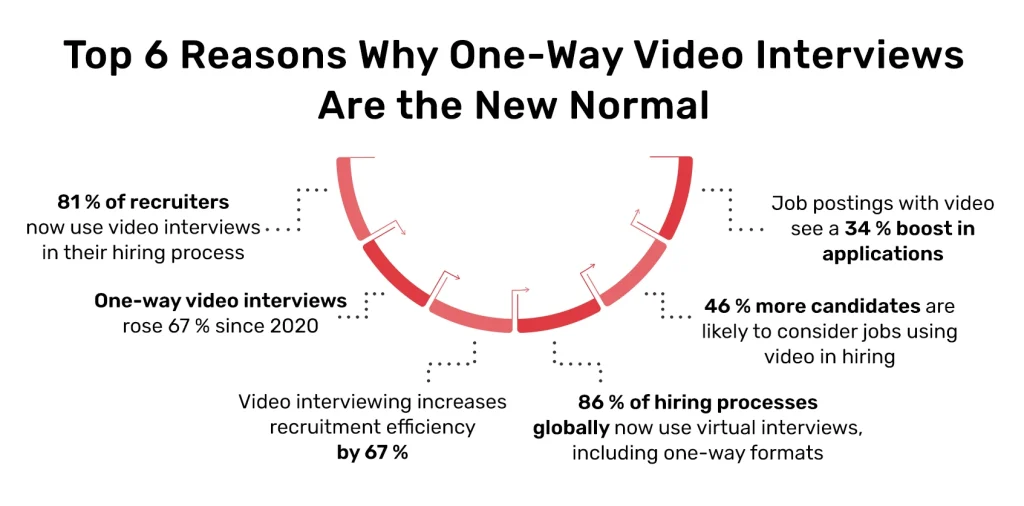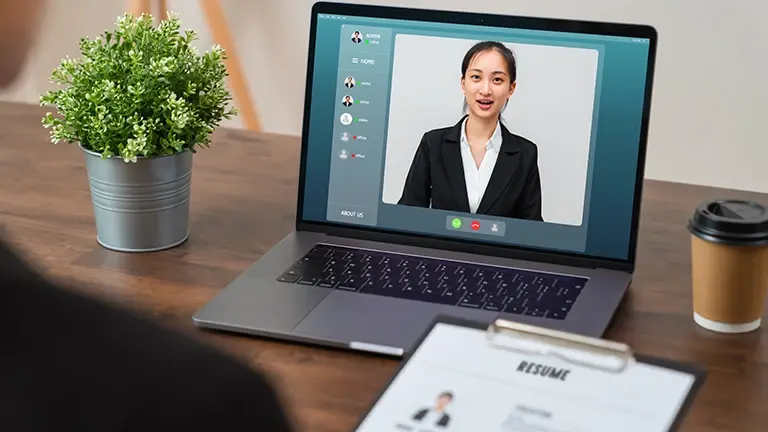As hybrid teams stretch across time zones and hiring goals tighten, talent leaders are looking for a calmer, more consistent first step in the funnel — one that trades calendar chaos for structure and speed. That’s the promise of one way interview: short, structured screening that candidates record on their time, and recruiting teams review on theirs. In a North American market where remote and hybrid work are still widespread — roughly a quarter of U.S. workers were remote at least some of the time in 2024 — flexible hiring workflows have a real operational edge.
In this blog, we’ll unveil why this one-way video interview software is becoming the go-to for recruiters across the world and why recruiting teams can’t live without them. You’ll learn what this interview actually is, how it stacks up against live video chats, its standout features, benefits, and how to leverage them for smarter hiring.
Let’s go.
Table of Contents
ToggleUnderstanding One-Way Interview
One-sided video interview is a pivotal part of an ATS tracking system. Also called asynchronous, recorded, or digital interviews, one-way video interview lets candidates record their responses to pre-set questions at their convenience—with no recruiter present live. Think of it like an audition tape: companies push questions via a platform, candidates record themselves answering, and recruiting teams review when it suits them.
These interviews usually surface early in the recruitment funnel — right after resume screening. They’re perfect when you’re flooded with applicants or when candidates are scattered across time zones. And in today’s remote-first world, they’ve seamlessly integrated into ATS platforms and recruitment automation software , syncing data, analytics, and playback into recruiters’ dashboards.
How do one-way video interviews differ from live video interviews?
One-sided video interview differs from live video interviews in many ways:
- Timing– Live video requires a shared hour and a stable connection for everyone. Asynchronous requires neither. A talent can record his response on his own time, while a recruiter can screen the talent’s response as per his convenience.
- Candidate experience– Live conversations test improvisation and rapport. A recorded screen tests clarity, preparation, and authenticity under light constraints. Done right, the latter reduces nerves by letting candidates choose a calm moment and environment, often improving fairness for those who can’t step away midday.
- Interviewer efficiency– Booking five 30-minute screens can burn hours before a single assessment begins. It is noted that interview hours per hire have stayed elevated since 2022; shifting the first step to on-demand reviews recovers time you can reinvest in deeper, later-stage assessment.
- Tech setup– Live video depends on perfect timing, bandwidth, and join links. Asynchronous tools ask less of the network and support retries. That reduces “no-shows” and tech-glitch false negatives — quietly improving your funnel health over a quarter.

Top 7 Features of One-Way Video Interview
Recruiting isn’t hard because of bad candidates—it’s hard because of all the little things that eat up your time. One-sided video interviews are built to solve exactly that.
-
Customizable Questions
You spend half your week repeating the same “walk me through your background” spiel to different candidates. By the fifth call, you sound like a broken record.
With one-sided video interview software, you set your questions once — whether it’s text or a short video of you asking them — and every candidate answers the same way. According to a 2024 Statista report, over 65% of U.S. recruiters now use standardized video prompts to cut down early screening time.
- Time Limits & Response Settings
Phone screens can spiral into 45-minute monologues when you only needed 5 minutes of context. Multiply that by 20 candidates and your week is gone.
One-sided interview platforms let you set time caps — say, 90 seconds to answer a question. This keeps responses sharp and comparable, while saving you hours of listening time. As per a Forbes report, recruiters who use time-boxed video interviews report 40% faster screening cycles.
- Re-Recording Options
Some candidates bomb the first take because they’re nervous. Others ramble like it’s a TED Talk. Either way, you’re not seeing their best shot.
You choose whether candidates can re-record or submit one take only. Want authentic, in-the-moment answers? One take. Want polished, thoughtful responses? Allow a redo. As stated in a 2024 CNBC report, this flexibility is why 74% of candidates say pre-recorded video interviews reduce early-stage stress.
- Branded Interface
Standard interview tools can feel cold and transactional, like candidates are just talking to a faceless bot. That’s not great for employer branding.
Modern one-sided video interview platforms let you add your logo, brand colors, and even a welcome video. Candidates get a sense of your company culture from the very first touchpoint, which increases candidate engagement by 28%.
- Built-In AI Analysis
After 30 back-to-back candidate videos, everything starts to blur. Who had the strong software development experience? Who froze under pressure? It’s hard to keep track.
Many platforms now include AI analysis — tracking tone, keywords, and even soft skills — to highlight key takeaways. It doesn’t replace your judgment, but it keeps you sharp. Bloomberg (2025) notes that companies using AI-driven ATS systems see up to 60% faster shortlisting.
- Seamless ATS / CRM Integration
Juggling multiple tools is messy. Resumes live in one system, interview notes in another, and video files somewhere else.
One-way video interview platforms integrate directly with your ATS tracking system or recruitment automation software. Everything — resume, video response, and recruiter notes — lives in one place. That’s why 7 in 10 recruiters now prefer interview tools that sync with their ATS (Statista, 2024).
- Analytics Dashboard
You know some candidates drop off after starting, but you don’t know why. And you can’t improve what you can’t measure.
Analytics dashboards show you completion rates, average response times, and even which questions cause the most drop-offs. It’s not just data for the sake of data, it’s insight you can actually use to refine the process. Companies tracking candidate engagement with dashboards report 30% lower dropout rates (Forbes, 2024).
These features aren’t “nice-to-haves.” They’re practical fixes to the headaches recruiters deal with every single day — scheduling nightmares, time drains, candidate drop-offs, and bias creeping into decisions.
Top 5 Benefits of One-Way Video Interview
One-sided video interview offers multiple benefits:
- Saves Recruiter Time
Scheduling early screens feels like calendar Tetris, eating up hours. Candidates record when it works for them, and recruiters review when it fits their day.
- Standardized Evaluation
Live interviews can go off-track—some candidates get “softballs,” others don’t. One-sided interviews deliver the same questions, the same way, to everyone.
- Faster Screening at Scale
High-volume hiring overwhelms recruiters fast. With one-sided video interview, dozens of applicants can be screened in half the time.
- Improves Candidate Pool Quality
Phone screens often miss strong candidates who just don’t “shine” live. One-sided video interview gives every applicant the same stage and lets recruiters re-watch answers for fairness.
- Enables Data-Driven Hiring
Traditional interviews leave little measurable data. Modern one-sided video interview platforms pair with ATS, surfacing insights on keywords, tone, and completion rates.
Key Takeaways
- One-way interviews offer the flexibility and efficiency today’s remote-first recruiters need.
- Structured, asynchronous format means no scheduling, faster turnarounds, and fair evaluation.
- Robust features — from re-recording to AI analytics — make them powerful tools in your hiring tech stack.
- Benefits include time saved, better candidate engagement, scalable high-volume screening, fairness, and broader reach.
FAQs
It's an asynchronous video interview where candidates record answers to pre-set questions, reviewed later by recruiters.
Most platforms are mobile-friendly and intuitive. Still, provide clear instructions and tech tips to ease anxiety.
Absolutely—companies report up to 75 % reduction in resume reviewing time and 36 % faster scheduling.
Yes, many platforms use AI to score tone, word choice, and soft skills — but always pair AI with human judgment for fairness.
Definitely. Use one-way as a first filter, then invite finalists for live chats to build rapport and dive deeper.
Choose a solution with robust integrations so invites, scores, and notes sync automatically. That protects data integrity and simplifies reporting—particularly when leadership asks for funnel metrics by stage.

